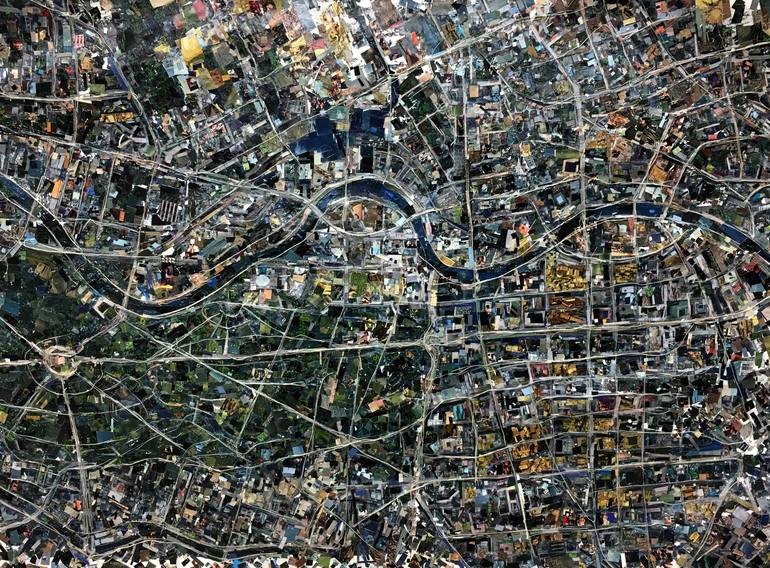






VIEW IN MY ROOM
East and West Berlin, Germany Collage
Germany
Collage, paper on Paper
Size: 27.6 W x 19.7 H x 0.4 D in
Ships in a Box
Shipping included
14-day satisfaction guarantee
Artist Recognition

Artist featured in a collection
About The Artwork
The Berlin Wall, a guarded concrete barrier that physically and ideologically divided Berlin, stood from 1961 to 1989. It became a symbol of East/West relations during the Cold War. Now in Berlin, bright modern buildings sit next to ones pockmarked with bullet holes. The scars of the wall still remain, however, the city bears them through cobblestones that trace the Wall’s path, along with the thousands of cherry trees Japan sent to commemorate the reunification and slabs of graffiti-covered concrete Wall that serves as outdoor art galleries. The collage has images of buildings and trees, colors and patterns that are stitched together with layers of thread that travel through areas that once were blocked. There is a slight reflection/glare at the top of the photo. It is all mounted on high quality watercolor paper. This is part of the "The Borders We Create" series focused on the borders we create and the tension that is fueled by a line on a map. It also asks the question, should we all be citizens of the world? Borders change over time sometimes through violence, other times land is traded or sold peacefully or it is parceled out through international agreements. Borders can be open or heavily militarized. They can be geographic or established through agreements between political or social entities. What is a border but a line drawn on a map? Through collage Jessica Russo Scherr presents images that highlight the privilege and turmoil that permeates global migration. She creates views that erase the lines that appear on maps in order to look at the land without the political constructs that cause so much pain and agony. In many cases there are small bits of images or material that add layers of metaphor beyond the blurring of borders.
Details & Dimensions
Collage:paper on Paper
Original:One-of-a-kind Artwork
Size:27.6 W x 19.7 H x 0.4 D in
Frame:Not Framed
Ready to Hang:Not applicable
Packaging:Ships in a Box
Shipping & Returns
Delivery Time:Typically 5-7 business days for domestic shipments, 10-14 business days for international shipments.
Handling:Ships in a box. Artists are responsible for packaging and adhering to Saatchi Art’s packaging guidelines.
Ships From:Germany.
Customs:Shipments from Germany may experience delays due to country's regulations for exporting valuable artworks.
Have additional questions?
Please visit our help section or contact us.
Germany
American artist living in Frankfurt, Germany. Her work investigates our place within the wider cultural and emotional landscape focusing on identity, memory, nostalgia, and narratives as well as connections to others and place. The handling of her chosen media is often applied in overlapping and mirrored layers forming atmospheric portraits and landscapes that intentionally evoke sensations of memory recollection and internal evolution. Her subjects are frequently depicted in solitary, social and spiritual situations. Jessica is an internationally exhibiting artist and recipient of the prestigious Fulbright Grant by the U.S. State Department for her work in art. Jessica is originally from New York and has lived in 5 countries. She calls Germany her home now along with her husband and two children.
Artist Recognition

Artist featured by Saatchi Art in a collection
Thousands Of Five-Star Reviews
We deliver world-class customer service to all of our art buyers.
Global Selection
Explore an unparalleled artwork selection by artists from around the world.
Satisfaction Guaranteed
Our 14-day satisfaction guarantee allows you to buy with confidence.
Support An Artist With Every Purchase
We pay our artists more on every sale than other galleries.
Need More Help?